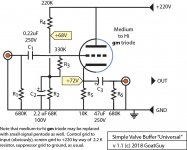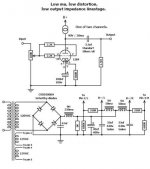Your diagram shows a decoupling cap at the junction of the 220k and 68k. Assuming an appropriate value for this, the 51k only applies at DC and subsonic frequencies.
Headslap-to-self. Of course. OK, "no 51 kΩ add-in" That decoupling cap axes the value. Thanks! GoatGuy
The diagram says medium to high mu triode. For good performance as a cathode follower you need high gm, not high mu. For use with lowish supply rails and lowish value load resistances (as seen in that circuit) you need lowish mu.
Where does the 51k come from?
About what you say, is that diagram not suitable for a buffer with ECC88 tube?
I use this design myself. Active loaded CF Buffer. Adjust the 1u cap to suit your load and desired LF cutoff.
That is a nice design. The only real reason I chose "1 valve" is because the OP seemed interested in something simple and low in tube count.
It hardly remains simple when one takes the time to add components that allow "it" to work safely in stand-alone who-knows-how-it'll-be-connected-in-the-future mode. See diagram attached.
GoatGuy
Attachments
The ECC88 has very high gm and mid-range mu so should make a good cathode follower. It is designed to work well at lowish voltages.indaco said:About what you say, is that diagram not suitable for a buffer with ECC88 tube?
Last edited:
stocktrader₂₀₀;5303048 said:C₃ should be no bigger then 3.3uf which provides a low pass of 20Hz at a load of 2500 Ω.
It was selected to give –1 dB at 600 Ω load; if 2,500 Ω load is the target, then of course you're right. It just depends on the load. GoatGuy
OK. Then use a polypropylene, film capacitors. Key is 250+ VDC and ≥ 1 μF for a GainClone type chip amp. Chip amps tend to have 10 kΩ input impedance.
Representative, for $1.90 ea: DPM2W1K-F Cornell Dubilier - CDE | Mouser as an example of an excellent capacitor for a darn-good price.
(But note: as soon as I say excellent, out from the closet will come a bunch of folk who will rebut this and offer no end of even better capacitors. Its up to you.)
GoatGuy
Representative, for $1.90 ea: DPM2W1K-F Cornell Dubilier - CDE | Mouser as an example of an excellent capacitor for a darn-good price.
(But note: as soon as I say excellent, out from the closet will come a bunch of folk who will rebut this and offer no end of even better capacitors. Its up to you.)
GoatGuy
I have a four year old hybrid amp design that uses a tube front end that provides all the signal voltage amplification. It's capacitively coupled to class AB solid state stage with a gain of 1. I call this SS stage the "tube buffer". It can deliver 70 watts of power with modest heatsink. It uses complimentary darlington pair transistors in the output driven by some high voltage albeit smaller driver transistors. The output stage has discrete current sense and protection - quite indistuctible. There are a total of 7 transistors in the tube buffer. There is no global feedback used. Oscillation in the output is prevented with a single cap in the output bias section.
This approach eliminates that large/heavy/expensive tube output transformer.
I started out using the 6SN7 for tubes but found it to be very microphonic. This amp is a guitar combo amp. (I like warm clean, not distorted). I changed from the 6SN7 to the 6SL7 which is similar but has higher gain and is way less microphonic. I did not detect a change in the sound quality. I suppose if your amp is seperate from your speaker, microphonics isn't much of a problem.
I found my B+ couldn't be much less than 200VDC in order to get enough excusion to create 70 watts RMS into 8 ohms. Even then I had to use a "White Cathode follower" as the last tube stage in order to get the most swing out of 200VDC B+.
I'd be happy to pass along the design to any individual.
This approach eliminates that large/heavy/expensive tube output transformer.
I started out using the 6SN7 for tubes but found it to be very microphonic. This amp is a guitar combo amp. (I like warm clean, not distorted). I changed from the 6SN7 to the 6SL7 which is similar but has higher gain and is way less microphonic. I did not detect a change in the sound quality. I suppose if your amp is seperate from your speaker, microphonics isn't much of a problem.
I found my B+ couldn't be much less than 200VDC in order to get enough excusion to create 70 watts RMS into 8 ohms. Even then I had to use a "White Cathode follower" as the last tube stage in order to get the most swing out of 200VDC B+.
I'd be happy to pass along the design to any individual.
Hi campsquire, from what you say you coupled SS + tube that would be the opposite that I intend to. In fact my aim is to add some "tuby taste" before the amp stage, I don't care about high impedance source like guitar, etc. I'll never link in the chain. Anyway your contribuition wuold be appreciated, just as to compare with the others ideas. Thanks, Indaco
In fact my aim is to add some "tuby taste" before the amp stage
So, you want an effects machine. Be advised that a properly functioning cathode follower (buffer) is highly transparent.
In fact my aim is to add some "tuby taste" before the amp stage
You are wasting your time if you think a tube buffer will give you that "tubey" character. A properly designed and implemented cathode follower/buffer will be very transparent and add little character of its own at all to the sound. If you want to get that "tube" sound and bend, a low voltage, low gain preamp will work better for you, lower supply voltage will give the tube less gain and make it less linear (at least with most triodes like the 6SN7) but it wil still sound fantastic, with a pile of even harmonics to make it sound good and "tubey" for you.
Last edited:
I have a four year old hybrid amp design that uses a tube front end that provides all the signal voltage amplification. <snip>
This sounds pretty neat, and I would love to see some more info and a discussion on it in another thread.
Indaco, regarding tube front end tubey character, I'd have to agree with Lingwendil, I've found the output transformer is a factor in achieving that character. I put a very small output transformer in the middle of the tube section in my afore mentioned hybrid amp design. I use it to drive an effects loop and headphone jack. This transformer is always in the cicuit and its' ouput gets reamplified by another 6SL7 section then onto the SS amp. I've noticed the compression and volume swell affect you get when you strike a guitar chord heavey handed with an all tube amp is restored. For one the B+ collapses momentarily. I believe this accounts for most of the "tubey affect" reardless of wether the app is hifi or guitar.
...A properly designed and implemented cathode follower/buffer will be very transparent and add little character of its own at all to the sound. If you want to get that "tube" sound and bend, a low voltage, low gain preamp will work better for you...
What do you mean exactly for "character"? I like the neutral, natural sound but if I someways can improve some characteristic of sound itself (not necessarely tubey) It would be welcome. I'd like to experiment. Time ago I build a hybrid headphone amp but I wasn't so happy for the result as I expected. I think all is relative. Maybe before I didn't express myself well: I meant if there is something positive that a tube can offer I'm curious to listen to, maybe I will like it
You are wasting your time if you think a tube buffer will give you that "tubey" character. A properly designed and implemented cathode follower/buffer will be very transparent and add little character of its own at all to the sound. If you want to get that "tube" sound and bend, a low voltage, low gain preamp will work better for you, lower supply voltage will give the tube less gain and make it less linear (at least with most triodes like the 6SN7) but it wil still sound fantastic, with a pile of even harmonics to make it sound good and "tubey" for you.
Lingwendil speaks the truth. The signal portion of the provided 12B4 setup, using a 10M45S as the CCS, rates to produce the desired "touch" of 2nd order HD into a chip amp's 10 Kohm I/P impedance. The costly 3.3 μF. Mundorf cap. shown most definitely need not be used. A 4.7 μF. metalized polypropylene part bypassed by a 0.47 μF. 716P series "Orange Drop" will be quite adequate.
Remember, this is an effects machine, not HIFI.
Attachments
Used properly, a tube can offer a signal coming out which is virtually identical to the signal going in. Sadly, this is not what people usually mean by 'tube sound'. No device can positively add something to the signal to make it more like the original signal, because the original signal is not available to us; we only have a signal which has already passed through many stages. What can be done is to sprinkle favoured distortions to taste, like people seasoning food.indaco said:Maybe before I didn't express myself well: I meant if there is something positive that a tube can offer I'm curious to listen to, maybe I will like it
It's true. I design with tubes for many reasons, mainly ease of design, how forgiving they are of overloads compared to SS parts, and how linear (clean) the output is for such a simple circuit. Sure it's not as efficient, put that's the cost of the simplicity IMHO.
Last edited:
A 4.7 μF. metalized polypropylene part bypassed by a 0.47 μF. 716P series "Orange Drop" will be quite adequate.
Remember, this is an effects machine, not HIFI.
I also get excellent results with X2 PP safety caps for bypass and coupling. Carli and Tenta come to mind. You could use 2 in parallel of these: 10pcs X2 Polyproplene safety capacitor 2.2uF 275VAC 225K P=27mm | eBay
Last edited:
Used properly, a tube can offer a signal coming out which is virtually identical to the signal going in. Sadly, this is not what people usually mean by 'tube sound'. No device can positively add something to the signal to make it more like the original signal, because the original signal is not available to us; we only have a signal which has already passed through many stages. What can be done is to sprinkle favoured distortions to taste, like people seasoning food.
Any number of people find, while it's not HIFI, 2nd order harmonic distortion to be euphonic. It's easy enough to tweak modest cost tubed circuitry into generating the desired 2nd harmonic, while avoiding odd order products, which tend to be very irritating. Perhaps a triode effects machine in combination with the chip amp will produce a net distortion spectrum that's to the OP's liking. All of this is very much like locking the barn doors, after the horse is gone.
- Status
- This old topic is closed. If you want to reopen this topic, contact a moderator using the "Report Post" button.
- Home
- Amplifiers
- Tubes / Valves
- Suggestion for a tube buffer

